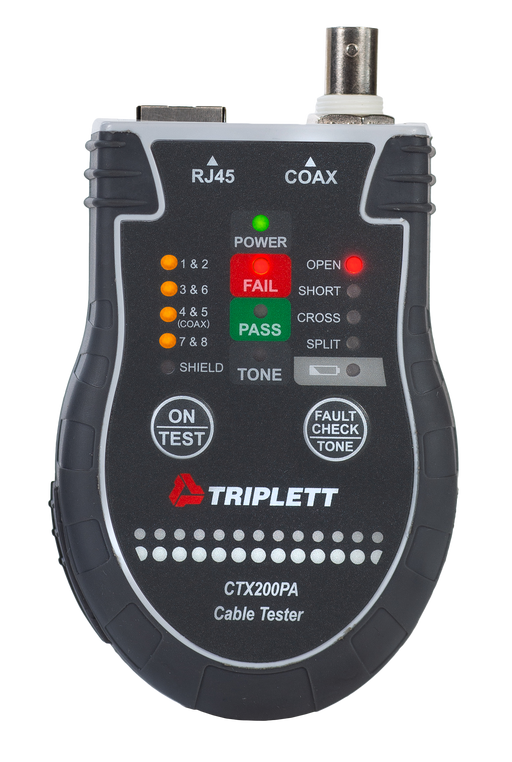Know More Continuity Testers
WWhat is a network cable continuity tester?
A network cable continuity tester checks and issues instant output regarding the circuit status of Ethernet cables such as Cat5, Cat6, and other versions. There are testers to check the same parameters for coaxial cables, telephone wires, and more. These testers check for wiring issues, breaks, reversals, twisted pairs, and shorts in a cable and conclude if a wiring path can be established between the two ends of that cable.
Importance of using network continuity testers
Here are some reasons why network continuity testers are important.
- They ensure safe working of a cable and help identify if the path is active and open.
- They validate a new or upgraded network or electrical installation. Using these testers, network engineers can ensure the wiring is correct and meets the required industry standards.
- They are useful when troubleshooting network issues as they help isolate the problem by testing each cable. Network engineers can test each cable or possible faulty cables separately and quickly identify faulty or misconfigured connections. This speeds up the troubleshooting process and reduces downtime.
- Network cable continuity testers can help with cable management by confirming the labeling and organization of cables. It becomes easy to document the output records, connections, cable routing, and labeling. This reduces the effort required for future maintenance.
Types of continuity testers
These devices can be differentiated based on specific features such as non-contact testing, tone generation, testing multiple parameters, ones with LEDs and audible signals, and so on. However, these are the two broad types of continuity testers which may have all of these features. Triplett offers continuity testers which can perform TIA568 tests for RJ45 connector Ethernet cables as well as coaxial cables with a single device.
- RJ45 continuity tester: This device is typically designed to test continuity for Ethernet cables such as Cat5 and Cat6, onwards. It comprises a transmitter and receiver with former connected to the cable and the latter to the device end. It comes with LED indicators that flash depending on the output, such as pass or fail. Some models may have audible tone as well.
- Coax continuity tester: These devices are used to check the continuity in coaxial cables. This also has a transmitter and receiver which work with the same principle as RJ45. They also have indicators such as LEDs and audible alarms. Coax is displayed using the 4/5 LEDs. The coax remote is in the pouch.
How do network cable continuity testers work?
Network cable continuity testers validate the integrity and connectivity of either Ethernet cables or coaxial cables. They help identify wiring issues such as loose connections, breaks, shorting possibilities, and more. Here is how these continuity testers work.
- A continuity tester determines the path between two ends of a cable, it does so with the help of a power source or battery, a transmitter and receiver.
- The transmitter end is connected to the cable connector, and the receiver is connected to the device end.
- To facilitate inter-device connection, the cable path needs to be clear and open, which is tested by this device. For instance, in any Ethernet UTP cable, there are four twisted pairs of wires which forms a single cable. The device checks through each of these wires for breaks, incorrect pairing, open circuits, resistance and so on. It can also check patch cables before they are connected.
How to use network continuity testers?
Here are the steps to use network cable continuity testers
- First and the most important step is to deactivate the circuit where a cable needs to be tested. Continuity testers are never used on live circuits.
- Determine the type of cable to be tested. Most of the models we offer are suitable for more than one type of cable.
- In case of Ethernet cables, the pairing must be done correctly with appropriate connector pins 1,2; 3,6; 4,5; and 7,8. In case of pairing error, our testers will return a message such as “split pairs”.
- For primary or installed cables, connect the main unit to the wall jack, and then the remote to the patch panel or far-end wall jack. In case of patch cable, connect the main unit and remote directly to the cable ends.
- Switch on the power button of the device and start testing. Either pass of fail buttons will flash depending on the cable path.
- Now, press the fault button to check for isolated problems such as wiring issues.
- The process is almost similar for coax cables.
Factors to consider when choosing a network continuity tester
Some basic but important factors to consider are listed here.
- Versatility of the tester, which is how many types of cables can it check
- Compatibility with various connector types such as RJ45, RJ11, BNC, and more
- User-friendly menu and a compact size
- Certifications from American National Standards Institute (ANSI), the Electronic Industry Association (EIA)
- Must cover maximum tracings, number of wires, and other test points
- Additional features in a continuity tester
Browse More Electrical Test & Measurement Collections
Multimeters & Clamp-On Meters:
| Multimeter Cases | Clamp-On Multimeters | Digital Multimeters |
| Railroad VOM Test Sets | Voltage & Current Dataloggers | Magnetic Field Testers |
| AC Voltage Detector | Continuity Testers | Test Leads |
Electrical Accessories:
| GFCI Receptacle Testers | AC Line Splitters | Electrical Hand Tools |
| Non-Contact Voltage Detection Pens | Circuit Breaker Tracers |
Megohm & Resistance Testers:
| Megohmmeters - Insulation Testers | Earth Ground Resistance Testers |
Live Wire Circuit Testers:
| Live Wire Tone & Probe Kit |
Specialty:
| Power Supplies | Motor & Phase Rotation Testers |

